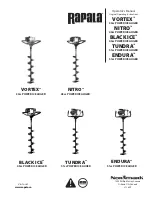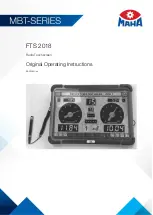
b.
Connect the other end of the user-supplied 22
gauge wire to the control cable’s brown wire at the control head as
shown in figure 2. Use an insulated connector for this connection.
D.
Inspection and Final Installation.
1.
Ensure that there are no loose wire strands or other
bare wires which may cause a short circuit. Also, all wires must be
protected from any sharp edges which could eventually cut
through the insulation.
2.
Connect the 14-gauge red wire to the (+) positive
terminal of the battery using an in-line, user-supplied fuseholder
and 25A fuse. Locate the fuse as near the battery as possible to
protect the entire length of wire.
NOTE
All directional lamps will illuminate simultaneously if
the power supply leads are reversed. Correct the wiring
before proceeding.
3.
Read and understand paragraph IV OPERATION,
and test for proper operation of all functions.
IV.
OPERATION.
SAFETY MESSAGE TO OPERATORS
Peoples’ lives depend on your safe use of our products. Listed
below are some important safety instructions and precautions you
should follow:
•
Although your warning system is operating properly,
it may not be completely effective. People may not
see or heed your warning signal. You must recognize
this fact and continue driving cautiously.
•
Also, situations may occur which obstruct your
warning signal when natural or man-made objects
are between your vehicle and others, such as: raising
your hood or trunk lid. If these situations occur, be
especially careful.
•
At the start of your shift, you should ensure that the
light is securely attached and all lamps are operat-
ing properly.
•
If a selected function does not perform properly or if
any of the lamps remain illuminated when the
control is off, disconnect the power connector from
the control unit and contact the nearest service
center.
Failure to follow these safety precautions may result in
property damage, serious injury, or death to you, to passengers, or
to others.
RETAIN AND REFER TO THIS MESSAGE
A.
On/Off Switch.
1.
OFF Position.
The SignalMaster is available for the low power
warn signal if the vehicle ignition switch is on and the vehicle
parking brake is applied.
2.
ON Position.
a.
The switch will illuminate. If the switch does
not illuminate, check the switch bracket ground lead for proper
chassis ground connection.
b.
The directional/hazard patterns will operate as
selected by the Hazard Rocker Switch.
B.
Hazard Rocker Switch.
NOTE
These patterns will override the low power warn signal.
1.
LEFT Position.
In this position, the light produces a left arrow
flashing pattern, instructing traffic to move left.
2.
CENTER Position.
In this position, an alternating pattern is produced.
The four middle lights activate alternately with the two outside
lights on each side.
3.
RIGHT Position.
In this position, the light produces a right arrow
flashing pattern, instructing traffic to move right.
C.
Low Power Warn.
This pattern alternately flashes both end lamps on each
side of the light assembly.
To activate the low power warn pattern, the vehicle
ignition switch must be “on”, the SignalMaster’s on/off switch must
be “off”, and the vehicle parking brake must be applied.
CAUTION
Damage to the directional light assembly will occur if this
vehicle is jump-started when the light is “on”. Ensure
that the light is switched “off” before jump-starting this
vehicle.
V.
MAINTENANCE.
A.
General.
WARNING
Crazing (cracking) of lenses will cause reduced effective-
ness of the light. Do not use cleaning agents (which will
cause crazing) such as strong detergents, solvents, or
petroleum products. If crazing of lenses does occur,
reliability of light for emergency signalling purposes may
be reduced until lenses are replaced.
Ordinary cleaning of the plastic lenses can be accom-
plished by using mild soap and a soft rag. Should fine scratches or
a haze appear on a lens, they can ordinarily be removed with a
non-abrasive, high quality, one-step, automotive paste cleaner/wax
and a soft cloth.
B.
Lamp Replacement.
CAUTION
Use of higher wattage lamps can result in damage to the
colored lenses.
1.
See figure 3. Remove and retain the two screws
which secure the lens. Carefully pull the lens straight away from
the light assembly.
-3-






















